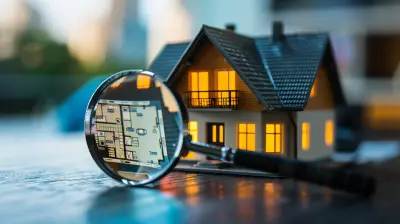29 March 2025
When it comes to real estate marketing, it’s not just about throwing a property listing on your website or signing up for a few ad campaigns. That’s like trying to catch fish with a stick—it might work, but it’s hardly efficient. What you really need is a well-thought-out strategy, and that’s where the real estate marketing funnel comes into play. A marketing funnel helps you guide potential clients from being curious website visitors to serious buyers or sellers (and, ideally, long-term clients).
In this guide, I’m going to break it all down for you—step by step. Whether you’re a seasoned realtor or a newbie trying to make a splash in the market, this is the strategy you need to stay ahead of the competition. So, grab your coffee (or tea), and let’s dive right in! 
What Is a Real Estate Marketing Funnel?
First things first—what even is a "marketing funnel?" Think of it as a journey. Imagine your clients are on a road trip. At the start, they might just be exploring neighborhoods. By the end, they’re pulling into the driveway of the home they just bought. The funnel guides them along this path, leading them from awareness of your services all the way to taking action (like purchasing a home or signing a contract).A real estate marketing funnel is split into several stages, each with its own specific goal. These stages are:
1. Awareness: Attracting potential clients.
2. Interest: Sparking curiosity and providing value.
3. Consideration: Building trust and showing why you’re the one they need.
4. Action: Closing the deal—whether that’s helping them sell their property or buy a new home.
Now that we’ve got the basics down, let’s start building one. 
Step 1: Start With a Strong Foundation – The Awareness Stage
Every great marketing funnel starts at the top, which is the widest part of the funnel. This is where people become aware of you and your brand. Think of it like a first impression—this stage is your chance to make it count.Create Captivating Content
You need to be where your audience is, and let me tell you, they’re online. Blogging, social media, and YouTube videos are your new best friends. Write articles about the local real estate market, share tips for first-time buyers, or create video tours of homes. High-quality, useful, and engaging content will help you show up when people search for real estate-related topics.For example, you could publish a blog on “10 Things Every First-Time Homebuyer Should Know.” Add some local SEO magic by including your city or neighborhood in the title. Suddenly, you’re ranking on Google whenever someone looks for real estate advice in your area. That’s how you attract leads.
Leverage Social Media
Let’s face it—everyone’s scrolling through Instagram, Facebook, and even TikTok these days. Use these platforms to showcase your listings, share testimonials, or provide valuable tips. Create posts that catch people’s attention, like “Home of the Month” features or reels with quick market updates.Oh, and don’t forget paid ads! Platforms like Facebook Ads Manager let you target your audience super specifically. Want to reach newlyweds searching for homes in your city? Easy. With just a few dollars, you can get your name in front of the right people. 
Step 2: Nurturing Leads – The Interest Stage
Alright, so they now know who you are. That’s great! But awareness alone won’t pay the bills. The next step is to hold their interest. You don’t want them to forget about you the second they scroll past your ad.Build an Email List
Here’s a pro tip: Your emails should be juicier than a gossip column. You want potential clients to look forward to hearing from you—not hit the delete button. Offer a lead magnet, like a free downloadable guide (“Top 5 Tips for Selling Your Home Fast”), in exchange for their email address.Once you have their email, send them helpful, engaging content regularly. For example:
- A monthly newsletter with market updates.
- Exclusive new listings before they go public.
- Tips and tricks for buying or selling.
Pro Tip: Use storytelling. Instead of just listing specs about a property, talk about the family who lived there and the memories they created—tap into emotions!
Retarget With Ads
Ever notice how you search for something online, and then you see ads for it everywhere? That's retargeting, and it works like magic. If someone visits your website but doesn't contact you, retarget them with ads that remind them what they’re missing out on.For example, if they looked at homes in a specific neighborhood, show them ads for properties in that area. It’s like a gentle nudge saying, “Hey, remember me?” 
Step 3: Make Them Trust You – The Consideration Stage
At this stage, your potential clients are interested, but they’re still on the fence. This is where you build trust like your life depends on it (because, let’s be honest, your business kind of does).Showcase Social Proof
People need to see that others trust you before they’ll trust you, too. That’s just human nature. Share glowing reviews and testimonials from happy clients. If you’ve won awards or received industry recognition, flaunt it!Better yet, create case studies with before-and-after stories. Did you help a client sell their home in two weeks above asking price? Share their journey—it’ll resonate with others.
Build a Personal Connection
People don’t just choose a real estate agent—they choose someone they like and trust. Go out of your way to connect on a personal level. Host webinars or local meetups where you can offer free advice. Share behind-the-scenes content of your daily life as an agent.When you’re authentic, people notice. They’ll feel like they already know you, which makes it easier for them to reach out when they’re ready.
Step 4: Seal the Deal – The Action Stage
Finally, it’s time to close the deal. This is where all your hard work pays off—but don’t get lazy now! You’re on the home stretch.Simplify the Process
Buying or selling a home is already stressful. Make the process as smooth as possible for your clients. Provide clear instructions, quick responses, and a helping hand whenever they need it.Keep the Lines of Communication Open
Imagine this: a potential client calls you, but you don’t answer. They send an email, but it takes you three days to reply. Guess what? They’ve already moved on to another agent. Be accessible and responsive—it’s one of the simplest yet most effective ways to stand out.Bonus Tip: Don’t Forget About Post-Sale Nurturing
You might think the funnel ends once the deal is done, but that’s a rookie mistake. Your past clients are a goldmine for referrals. Stay in touch with them through occasional follow-ups or holiday greetings. They’ll appreciate the gesture and might just send some business your way.Why Your Funnel Needs to Be Unique
Before I wrap this up, let me say this: no two real estate marketing funnels are the same. Your funnel should reflect you—your brand, your personality, and your market. Tailor your strategies to what works for your audience. Experiment, measure results, and tweak things as you go.And remember, a well-built funnel isn’t just about closing deals—it’s about creating relationships. Because at the end of the day, people don’t just buy homes; they buy trust, confidence, and peace of mind.
Final Thoughts
Building a real estate marketing funnel that works isn’t rocket science, but it does take some effort. Focus on creating valuable content, nurturing connections, and building trust at every stage of the funnel. And don’t forget, the key ingredient in any funnel is you. Your authenticity, expertise, and passion are what will ultimately turn leads into lifelong clients.So, go ahead—start building your funnel today. Before you know it, you might just be the go-to real estate agent in your area.





Xavi McVey
Great insights! Crafting an effective marketing funnel is crucial for success in real estate. Keep up the fantastic work!
April 2, 2025 at 8:27 PM